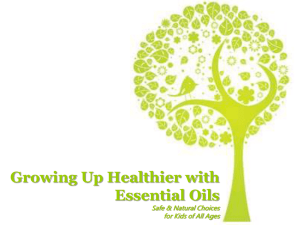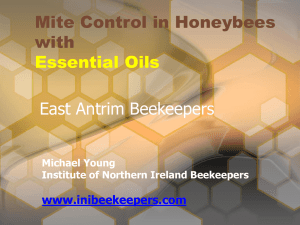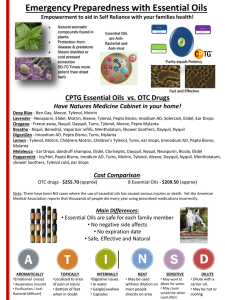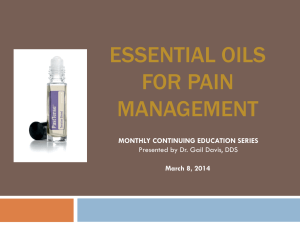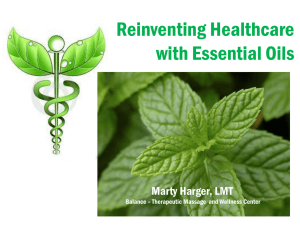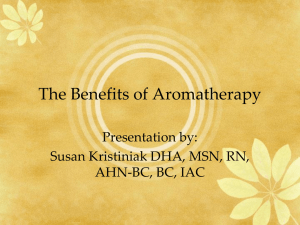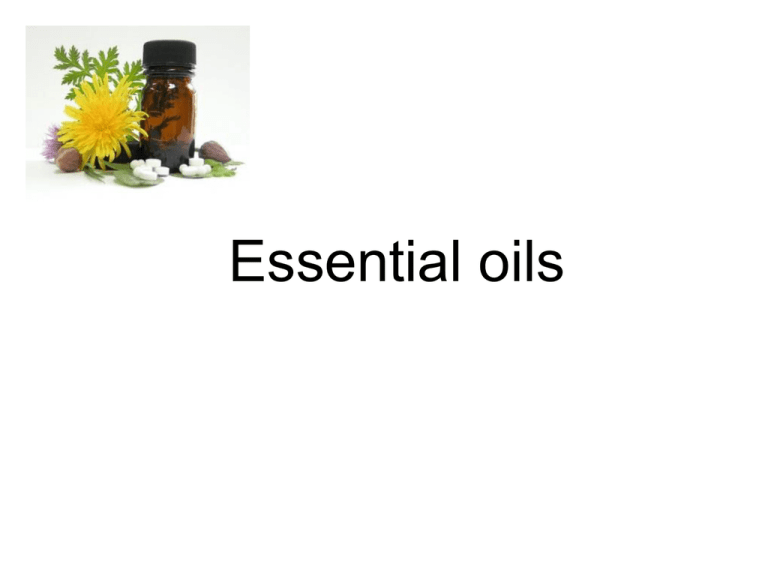
Essential oils
What is an essential oil???
• The blood of the plant
protects the plant from invaders
Helps the plant to heal from any wound
• Subtle volatile liquids distilled from plants,
shrubs, flowers, trees, roots, brushes, and
seeds.
• Chemically complex
– 1997 chemist had identified 70,000 different types of
aromatic molecules.
• Very Very Concentrated and powerful
How do essential oils work?
Essential oils enter the body in
three ways
• Inhaled
• Ingested
• Absorbed through the
skin
How does skin application
work
Essential oils can be applied topically to the skin.
Common examples include applying a blend that
contains wintergreen, helichrysm, clove, and
peppermint over soar joint to stop pain.
How does this work? Our skin is somewhat
permeable. The active chemicals in essential
oils are absorbed just like the ingredients in
common pharmaceuticals such as hormone
replacement therapy cream and nicotine
patches.
Factors that Increase Skin
Absorption
• Places on the body with greater
concentrations of sweat glands and
hair follicles, such as the genitals,
head, soles, palms, and armpits
• Massaging the area first will increase
circulation to that area, thereby
causing an increase in absorption of
essential oils.
• Heat will likewise increase circulation
and thus enhance absorption.
How to inhale essential oils
Another way that essential oils enter the body is
by inhalation either through the nose or
mouth.
Common examples include inhaling
peppermint essential oil to reduce fatigue or
nausea. (Note: Often, essential oils are put
into a diffuser for inhalation.
The Olfactory System
•
The olfactory system includes all physical
organs or cells relating to, or contributing to
the sense of smell. When we inhale through
the nose, airborne molecules interact with
the olfactory organs and, almost
immediately, the brain.
•
Molecules inhaled through the nose or
mouth are also carried to the lungs and
interact with the respiratory system. Thus,
inhaled essential oils can affect the body
through several systems and pathways.
Ancestors and Science
• Our ancestors recognized what science is now
proving,
• That scents can effect your emotions and your
brain waves.
• Studies have shown that scents inhaled effect
pulse rate, blood circulation and breathing.
• Other studies have shown brain wave changes,
sedating or stimulating, depending on the scent.
Anatomy of smell
• The sense of smell is the
only one of our senses that
is wired directly into the
brain so that the result is
immediate.
• During inhalation, odor
molecules travel through the
nose and affect the brain
through a variety of receptor
sites, one of which is the limbic
system.
“Smell is a potent wizard that
transports us across thousands of
miles and all the years we have
lived.” Helen Keller
The limbic system
• The limbic system is called the visceral or emotional brain, also the
old brain or reptilian brain.
• It is the part of the brain that was developed first before speech and
tools, the survival part of ourselves.
• It registers emotions, pleasure, pain, fear, anger, sorrow and sexual
feeling
• It controls the involuntary aspects of ourselves.
• It has nerve pathways to the hypothalamus and the autonomic
nervous system.
The hypothalamus controls the endocrine system that secretes
the hormones that effect growth, sex, metabolism, etc.
The autonomic nervous system controls unconscious activities
such as digestion, rate of heartbeat, body temperature and hunger.
Scents have far reaching effects upon the body
More about smell
• Humans can distinguish between 2000 and 4000 different odors,
depending upon the individual.
• Early man’s survival in the wild was greatly aided by his ability to
smell predator or prey before he could see or hear it.
• Smell is innate. It is an unconscious activity that has enormous
effect on our physiology.
• Another attribute of scent is that it is strongly connected to memory.
If you have a horrible memory of your third grade teacher who
always smelled of lavender, you would probably not find lavender
soothing and balancing as most people do. You may forever
associate that scent with unpleasantness. The same phenomenon is
experienced in smelling a scent connected to a loved one. A whiff of
a perfume can bring back memories of the most romantic night of
your life.
• When we are exposed to one smell for a long time it disappears
from our conscious awareness. The most obvious is the cook who
cannot smell the food cooking until she leaves and comes back into
the kitchen.
Ingesting essential oil
• The third way that essential oils enter the body is by
absorption through ingestion, or swallowing them.
• Some vitamin companies have used essential oils in
their products. They do this enhanced the potency and
absorbency of the supplement.
• Oral ingestion of essential oils is ONLY recommended
for those who have learned what oils are best for
ingestion.
Peppermint – put a drop on your tongue for hiccups
Lemon – put in water for immunity
Multi-dimensional in their
characteristics
1. Congenital realm
Problems that arise form heredity or as a result of complications
during pregnancy.
Here aromatic treatment can attempt to alleviate the consequences of
problems irreparable written in the genetic code or of events from
the time of conception until birth that have left a permanent
developmental mark
2. Organic realm
Liver, Kidney, Lungs, Spleen, Cardiovascular system, Digestive
system, ect.
3. Bio-electronic realm
Body pH
Oxidation reduction (detoxification pathways)
4. Microbial realm
Bacteria, Viruses, Parasites,
Multi-dimensional in their
characteristics
5. Immunity realm:
All the mechanisms within the body that protect against
infection
6. Structural realm:
bones, joints, muscles
7. Glandular realm:
Every gland in the endocrine (hormone) system.
thyroid, parathyroid, pancreas, ovaries, testis, ect.
8. Neruopsychic realm
Sympathetic and parasympathetic ns.
Libido
Endorphins
Emotions.
Essential Seven
Peppermint
Peppermint- Stops spasms
Use: upset stomach, cramping, gas,
bloating, heart palpations bug and
ant repellent
Application:
1. Rub on stomach or add 2-4
drops in water to help ease up set
stomach
2. Rub all over body for bug
repellent
3. Rub a drop under nose for heart
palpations and hold point with
finger
4. Massage into tight, painful
muscles
5. Improve concentration by
inhaling or diffusing
6. rub into temples to treat
headache
Essential Seven
Lemon
Lemon – Anti infectious.
according to Jean Vlanet MD: the
vaporized essence of lemon can kill
meningococcal bacteria in 15min,
typhoid bacilli in one hr. Staph aureus
in 2hrs, and Pneumococcus bacteria in
3hrs. Even a 0.2 dilution can kill
diphtheria bacteria in 20min and
inactivate TB in 20min. (PDR,
Essential science publishing)
Use: colds, fevers, soar throat, ear
infection, infections
Application:
1. Apply on throat, and behind ears for
any infection
2. Put 2-4 drops in water to purify
water and help get rid of infections
3. Add a few drops to water in spray
bottle for deodorizing and sterilizing.
4. Good for removing gum, wood
stains, and grease.
Essential Seven
Lavender
Lavender – calming, relaxing,
wound healing
Use: burns, cuts, wounds,
anxiety, sleeplessness,
depression, bug repellent
Application:
1. Apply to cuts, bruises, insect
bits and burns for rapid relief
and healing
2. Apply to heat stressed skin
3. Put a couple of drops in bath
tub or on pillow for relaxing
and reduction of negative
thoughts
4. Can be applied under arms
as deodorant
Essential Seven
Frankincense
Frankincense – Anti-tumoral,
Immuno-stimulant, antidepressant
Considered the “Holy anointing oil”
in the middle east and has been
used in religious ceremonies for
thousands of years.
Used to treat every conceivable ill
know to man thus is was valued
more then gold during ancient
time.
Stimulates the limbic system of the
brain along with centers in the
brain that signal hormone release.
Improves HGH production!
Use: Asthma, depression, ulcers,
cancers, hemorrhaging, herpes,
warts (virus)
Application:
1. Diffuse when there is concern
of infection in the area.
2. Diffuse daily if dealing with
depression
3. Apply topically several time a
day to wart or herpes infection.
4. Ingest orally to help immune
problems.
Essential Seven
Birch
Birch – soar muscles,
joints, bones,
inflammatory issues
Use: apply to any place
of pain
Application: apply 2-10
drops directly to area
of muscle, joint, or
bone pain/Arthritic
pain.
Essential Seven
Angelica
Angelica – anticoagulant, sedating,
anti-inflammatory to intestinal
walls.
Use:
Traditionally, Known as the “Holy
spirit root” or “the oil of angels”
by the Europeans, Angelica had
healing powers so strong that it
was believed to be of divine origin.
Bruises, colic, cough, respiratory
infection, indigestion, menopause,
PMS, rheumatism
Angelica brings memories back to the
point of origin before trauma or
anger was experienced, helping
us to release and let go of
negative feelings.
Application: Reflexology points or
diffuse:
Frequency: Approximately
85MHz
Essential Seven
Basil
Basil – relaxant
Traditional use: 16th century
powdered leaves were
inhaled to treat migraines
and chest infections. Hindu
put basil on the chest to
dead to protect them from
evil spirits, and the Italian
women wore basil to attract
possible suitors!
Use: Migraines, scanty
menstrual periods, Muscle
relaxant, URI, soothing to
insect bits
Application:
1. For migraines apply to tip of nose
and temples,
2. For mental fatigue inhale and
apply to crown of head, forehead,
heart and navel.
3. add to food or water for URI or
other infections.
Frequency: 52MHz
Frequency
Canned food and processed food – 0 MHz
Fresh Produce – 15MHz
Dry Herb – 12-22MHz
Fresh Herbs – 20- 27 MHz
Essential oils – 52 – 320MHz
Healthy body – 62-78MHz
Negative thought can lower frequency by 12MHz
Positive thought can raise frequency by 10MHz
Prayer and meditation can increase frequency by 15MHZ
Quality Control
Producing essential oils is very costly. It
often requires several hundred or even
thousands of pounds of raw plant materail
to produce a single pound of essential oil.
For example: It take three tons of melissa
to produce on pound of oil. Its extremely
low yield explains why it sells for $9,000 to
$15,000/Kilo.
Quality control
The vast majority of oils are produced for the perfume
industry, thus they are only interested in their aromatic
qualities.
High pressure, High temperatures, and the use of chemical
solvents are used in the distillation process to produce
greater quantities of oil at a faster rate.
To many these oils smell exquisite but lack true therapeutic
properties.
Many of the important chemical constituents necessary to
produce therapeutic results are either flashed off with the
high heat or do not have enough time to be released for
the plant material.
How to be sure
E.O is therapeutic
1.
2.
3.
4.
5.
Is the fragrance subtle, rich, organic, and delicate?
Are the herbs grown organically
Are the distillation facilities part of the farm where the
herbs are grown so they are freshly distilled, or do the
herbs wait for days to be processed; thereby losing
their potency?
Does the producer use low pressure and low
temperature to distill E.O. and are distillation cookers
fabricated from costly stainless steel alloys to reduce
the likelihood of the oils chemically reacting with the
metal.
Are the facilities scrutinized to check that no synthetic
chemicals are being used in any of the processes?
How to be sure
E.O is therapeutic
6. Is the Latin name of the plant provided so that you are sure you are
getting the right essential oil? For example, there are several
species of lavender.
7. Is the name of the country in which the plants were grown provided?
A consumer would not be expected to differentiate oils from
different countries, but this information is important to
aromatherapists because quality can vary by country. This is an
indication that the company is marketing to knowledgeable parties
as well as general consumers.
8. Is there a statement about purity? You should be informed if it is not
100% essential oil (meaning, it has been altered or mixed with
something else).
9. Does it smell as you expect it to smell?
10. Is there information about organic growing or wildcrafting (gathering
wild plants)? Most essential oils sold in the U.S. are not certified
as to their organic status, but some European brands are.
Places to buy essential oils
•
•
•
•
•
www.4Dshift.com
Young living essential oils
doTERRA essential oils
Mountain rose herbs
Aromaweb.com
– Lists several reputable companies
Essential oil books
• http://www.lifesciencepublishers.com
– Advanced aroma therapy
– Inner Transformations Using Essential Oils
– Essential Oils Integrative Medical Guide
– The Chemistry of Essential Oils Made
Simple


